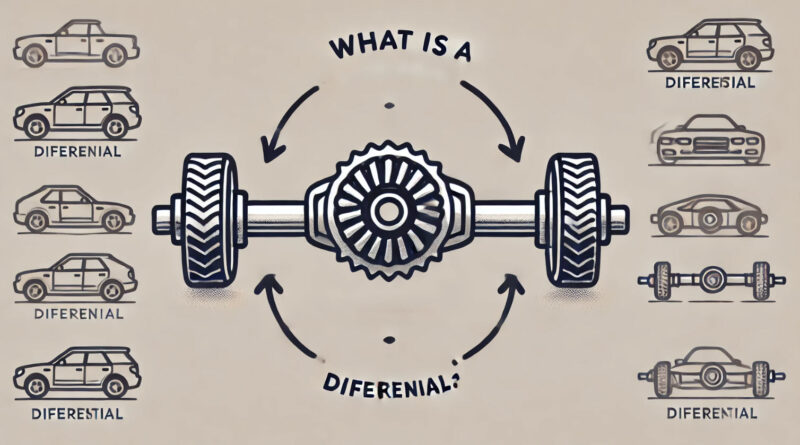What Is a Differential, and Why Does Your Car Need One?
Ever wondered how your car handles turns so smoothly without the wheels slipping or skidding? That’s thanks to a clever little component called the differential. It’s a key part of your car’s drivetrain that ensures your wheels spin at the right speeds, especially when cornering or driving on uneven terrain.
While it often goes unnoticed but plays a big role in making your car safe, smooth, and fun to drive. Let’s break it down into simple terms.
What Exactly Is It?
It is a mechanical device that sits in your car’s drivetrain. Its job? To allow your wheels to turn at different speeds.
This is super important when you’re taking a corner because the wheels on the outside of the turn need to cover more distance than the wheels on the inside. Without a diff, your wheels would be forced to spin at the same speed, which could lead to tire wear, loss of control, or even damage to your car.
How Does Work?
Here’s how it works, step by step:
- Splits Engine Power: The differential takes the power from your engine and splits it between the wheels.
- Adjusts Wheel Speed: When you turn, the differential ensures that each wheel spins at the speed it needs to maintain balance and control.
- Keeps Your Car Stable: By compensating for the difference in wheel speeds, it helps your car handle smoothly and safely.
Think of it as the peacekeeper between your wheels, making sure they work together without fighting against each other.
Where Is the Differential in Your Car?
The location of the differential depends on your car’s drivetrain setup:
- Front-Wheel Drive (FWD): The differential is part of the transaxle, which combines the transmission and differential into one unit at the front.
- Rear-Wheel Drive (RWD): The differential is at the rear axle, where it manages power to the back wheels.
- All-Wheel Drive (AWD) or Four-Wheel Drive (4WD): These vehicles often have multiple differentials—one at the front, one at the rear, and sometimes a center differential to balance power between the axles.
Types of Differentials
Not all differentials are created equal. Here are the main types and what they’re designed for:
1. Open Diff
- The most common type in everyday cars.
- Splits power evenly but lets the wheels spin at different speeds.
- Great for normal driving but struggles on slippery surfaces.
2. Limited-Slip Diff (LSD)
- Sends more power to the wheel with better traction when one starts to slip.
- Perfect for cars that deal with tricky conditions like snow, mud, or sand.
3. Locking Differential
- Locks both wheels on the same axle so they spin at the same speed, no matter what.
- Ideal for off-road adventures where maximum traction is a must.
4. Torque-Vectoring Differential
- Uses smart electronics to adjust power to individual wheels, improving handling during high-speed cornering.
- Found in performance and luxury cars.
5. Spool or Welded Differential
- Permanently locks the wheels together.
- Common in race cars but not practical for daily driving.
Why Is the Differential So Important?
Here’s why the differential is a crucial part of your car:
- Smooth Turns: It allows your car to corner effortlessly by adjusting wheel speeds.
- Protects Your Tires: Without a differential, your tires would wear unevenly and quickly.
- Improves Traction: In slippery conditions, certain types of differentials help keep your car stable.
- Enhances Handling: Advanced differentials, like torque-vectoring ones, make your car more responsive and fun to drive.
Signs Your Differential Might Be in Trouble
Like any car component, the differential can develop issues over time. Here’s what to watch out for:
- Weird Noises: Whining, grinding, or clunking sounds could mean the gears are worn or there’s a problem with the fluid.
- Leaking Fluid: If you see oil leaking near the differential housing, it’s time to get it checked.
- Turning Issues: A faulty differential can make your car feel stiff or jerky during turns.
- Vibrations: Unusual vibrations from the drivetrain could point to a problem with the differential.
If you notice any of these signs, don’t ignore them. A quick visit to the mechanic can save you from bigger (and costlier) repairs later.
How to Take Care of Your Differential
Keeping your diff in good shape isn’t hard, but it does require some basic maintenance:
- Check and Replace Differential Fluid: Over time, the fluid can break down and lose its effectiveness. Follow your car manufacturer’s recommended schedule for fluid changes.
- Inspect for Leaks: Regularly check for signs of oil leaks around the diff.
- Drive Smoothly: Aggressive driving can put unnecessary strain on your diff, so try to keep it easy on the throttle.
- Service When Needed: If you hear strange noises or feel something off during turns, get it looked at sooner rather than later.
Differential vs. Transfer Case: What’s the Difference?
While the diff manages wheel speeds on an axle, the transfer case is another component found in AWD and 4WD vehicles. It splits power between the front and rear axles, working with the diff’s to ensure all wheels are getting the right amount of power.
Final Thoughts
The differential might not be something you think about often, but it’s doing some serious work to keep your car running smoothly. From enabling effortless turns to improving traction and stability, this unsung hero of your drivetrain makes driving safer and more enjoyable.
So, the next time you’re cornering smoothly or cruising through tricky terrain, remember to thank your differential. And with a little maintenance, it’ll keep doing its job for many miles to come.
Buying a used VW. Buying used vauxhall, BMW, Jaguar, Ford, Volvo, Range rover, Bentley, Aston Martin, Porsche, Ferrari, Lamborghini, Maserati, Hyundai, Tesla, Honda, Pagani

